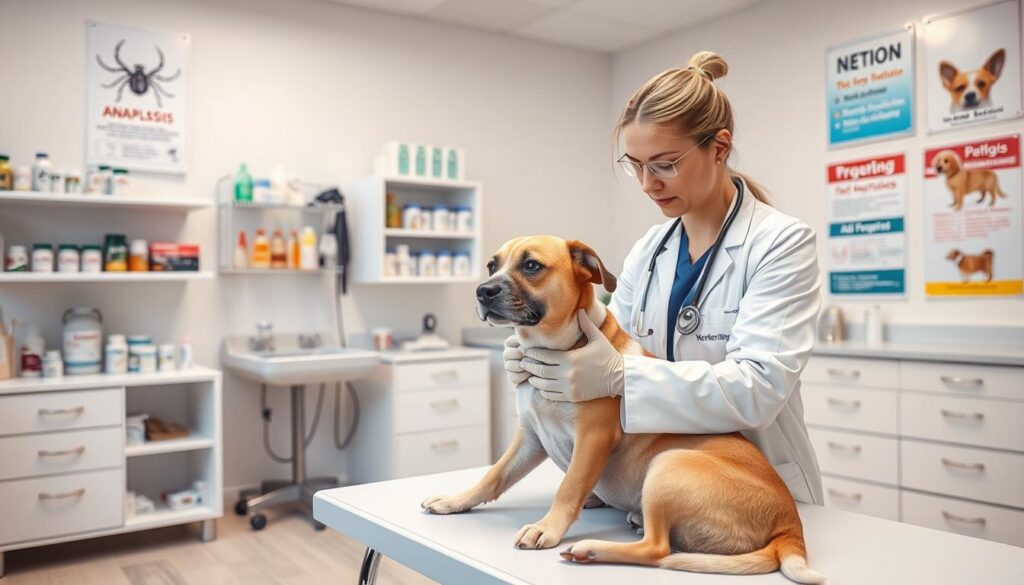As a pet owner, knowing about health risks is key. Anaplasmosis is a tick-borne disease dogs can get. This guide will help you spot the signs and find the right treatment. Knowing about this disease helps keep your pet healthy and happy.
Key Takeaways
- Anaplasmosis is a serious tick-borne disease that can affect dogs.
- Symptoms may include fever, lethargy, loss of appetite, and joint pain.
- Prompt diagnosis and appropriate treatment are crucial for a successful recovery.
- Preventive measures like tick control and regular veterinary check-ups can help reduce the risk of infection.
- Understanding the disease and its potential complications can empower you to provide the best care for your canine companion.
Understanding Anaplasmosis in Dogs: An Overview
Anaplasmosis is a serious disease in dogs caused by Anaplasma bacteria. It’s spread by ticks and can harm your dog’s health if not treated. Knowing how it spreads and where it’s found is key to keeping your dog safe.
What Causes Canine Anaplasmosis
Two types of bacteria, Anaplasma phagocytophilum and Anaplasma platys, cause anaplasmosis in dogs. These bacteria live in white blood cells and can cause severe symptoms.
How Dogs Get Infected
Dogs usually get anaplasmosis from tick bites. Deer ticks and brown dog ticks are common culprits. These ticks get the bacteria from infected animals and pass it to dogs.
Geographic Distribution of the Disease
Anaplasmosis is common in the northeastern and upper midwestern U.S. and parts of the Pacific Northwest. Deer ticks and brown dog ticks spread the disease in these areas. But, as ticks move, the disease is spreading too.
| Region | Anaplasmosis Prevalence |
|---|---|
| Northeastern U.S. | High |
| Upper Midwest U.S. | High |
| Pacific Northwest U.S. | Moderate |
| Southern U.S. | Low |
Knowing about anaplasmosis helps pet owners protect their dogs. Recognizing symptoms and preventing tick bites are important steps.
Common Signs and Symptoms to Watch For
It’s key to spot the early signs of anaplasmosis in dogs for quick treatment. This tick-borne disease shows different symptoms, so knowing what to look for is vital.
A sudden, unexplained fever is a main symptom of anaplasmosis in dogs. They might also seem tired, not want to eat, and have joint pain or stiffness. These signs can also lead to easy bruising or nosebleeds due to low platelet counts.
- Fever
- Lethargy
- Loss of appetite
- Joint pain or stiffness
- Decreased platelet count
- Easy bruising or nosebleeds
Anaplasmosis can also cause neurological issues like confusion, seizures, or loss of balance. These serious symptoms need quick vet care to avoid long-term problems.
“Rapid recognition of the signs and symptoms of anaplasmosis is crucial for the health and well-being of your canine companion.”
If your dog shows any of these worrying signs, get vet help fast. Early treatment can greatly improve their recovery chances and prevent long-term health issues.
Diagnosis Methods and Testing Procedures
Diagnosing anaplasmosis in dogs requires blood tests and lab work. Veterinarians first do a complete blood count (CBC) and biochemistry panel. These tests check the dog’s health and look for signs of the disease.
Blood Tests and Laboratory Work
The main test for anaplasmosis is a blood test for Anaplasma antibodies or the pathogen itself. There are several methods, like indirect fluorescent antibody (IFA) tests and enzyme-linked immunosorbent assays (ELISA). Polymerase chain reaction (PCR) testing is also used. These tests confirm the disease and rule out other causes.
Differential Diagnosis Considerations
Anaplasmosis symptoms can be like those of Lyme disease or ehrlichiosis. Veterinarians must consider these other diseases. They look for signs that help tell them apart to make an accurate diagnosis.
When to Seek Veterinary Care
- If your dog shows signs of anaplasmosis, see a vet right away.
- Early treatment is key to a good outcome. Untreated, the disease can get worse.
- Call your vet if you’re worried about your dog’s health or if they’ve been bitten by ticks.
Knowing how to diagnose anaplasmosis and when to see a vet helps your dog get the right care. This ensures they get the treatment they need.
Treatment Options for Infected Dogs
If your furry friend has been diagnosed with anaplasmosis, there are various treatment options available to help them recover. The primary approach is antibiotic therapy. This usually involves a course of doxycycline or other tetracycline-based antibiotics.
The treatment duration can vary. But, it’s usually recommended to continue the antibiotic regimen for 2-4 weeks. This depends on the infection’s severity and your dog’s response to the medication. It’s crucial to follow your veterinarian’s instructions carefully and complete the full course of treatment, even if your dog’s symptoms start to improve.
In addition to the antibiotic therapy, your veterinarian may also recommend supportive care measures. These help manage your dog’s symptoms and provide additional support during the recovery process. This may include:
- Fluid therapy to maintain hydration
- Anti-inflammatory medications to reduce inflammation and pain
- Medications to address specific symptoms, such as nausea or joint discomfort
Some dogs may experience side effects from the antibiotic treatment. These can include gastrointestinal issues or photosensitivity. If you notice any concerning side effects, be sure to communicate with your veterinarian promptly.
“Early and appropriate treatment is crucial for the successful management of anaplasmosis in dogs.”
With proper anaplasmosis treatment for dogs and supportive care, most infected canines make a full recovery. However, it’s essential to follow your veterinarian’s recommendations and closely monitor your pet’s progress throughout the treatment and recovery process.

Prevention Strategies and Tick Control
To keep your dog safe from anaplasmosis, start with prevention. A good tick control plan can lower the risk of your dog getting this serious disease.
Tick Prevention Products
Using tick prevention products is key. These can be collars, topical treatments, or oral meds. They keep ticks away and kill them before they can spread the Anaplasma bacteria. Talk to your vet to find the best one for your dog, considering their age, size, and how they live.
Environmental Control Methods
Don’t forget to tackle tick spots in your dog’s world. Keep your lawn short, clear out brush and tall grass, and spray your yard with a tick killer. This can cut down on ticks and lower the chance of your dog getting sick.
Regular Check-ups and Monitoring
Regular vet visits are vital for keeping your dog safe. Your vet can check for ticks, suggest prevention, and watch for signs of disease. Being proactive can help a lot in preventing anaplasmosis in dogs and keeping them healthy.
| Tick Prevention Product | Effectiveness | Duration | Application |
|---|---|---|---|
| Topical Spot-on Treatment | High | 1 month | Apply to the skin between the shoulder blades |
| Chewable Oral Medication | High | 1 month | Give orally, typically with food |
| Collar | Moderate to High | Up to 8 months | Attach to the dog’s collar |
“Consistent tick prevention is the best defense against anaplasmosis in dogs. Work closely with your veterinarian to implement a comprehensive plan tailored to your pet’s needs.”
Recovery Timeline and Prognosis
The recovery time for dogs with anaplasmosis can vary. It depends on how bad the infection is and how well the dog responds to treatment. Most dogs get better with quick and right veterinary care and go back to being healthy.
Here’s what you can expect during a dog’s recovery from anaplasmosis:
- Initial Symptoms: Dogs might start showing signs of illness 1-2 weeks after being bitten by a tick.
- Treatment and Antibiotics: Dogs get antibiotics like doxycycline to fight the infection. This treatment lasts 2-4 weeks.
- Clinical Improvement: Dogs start feeling better in 1-2 weeks after starting antibiotics. The medicine helps get rid of the bacteria.
- Full Recovery: Most dogs get better and can do normal activities again in 4-6 weeks with the right care.
The outlook for dogs with anaplasmosis is usually good. About 90% or more get better when treated quickly. But, some dogs might take longer to get better or have more serious symptoms. In rare cases, they might face complications that affect their health long-term.
| Recovery Milestone | Typical Timeline |
|---|---|
| Onset of Symptoms | 1-2 weeks after exposure |
| Antibiotic Treatment | 2-4 weeks |
| Clinical Improvement | 1-2 weeks after starting antibiotics |
| Full Recovery | 4-6 weeks |
Knowing the typical recovery time and chances of getting better helps pet owners support their dogs during this tough time.
Can Anaplasma in Dogs Go Away By Itself
Pet owners often wonder if anaplasmosis in dogs can heal on its own. The answer is no. Anaplasmosis is a serious tick-borne illness that needs professional medical treatment.
Anaplasmosis is caused by the Anaplasma bacteria, spread by infected ticks. These bacteria harm a dog’s body, causing fever, lethargy, loss of appetite, and joint pain. If not treated, the infection can become life-threatening.
Trying to wait for the infection to go away is very risky. The bacteria will keep growing and harming your dog. It’s important to get your dog to a vet for the right treatment.
“Anaplasmosis is a serious disease that requires prompt and proper treatment. Leaving it untreated can have severe, even fatal, consequences for your dog.”
With the right care, your dog can fully recover from anaplasmosis. It’s crucial to seek veterinary help early. This ensures a good outcome and prevents long-term health problems. Don’t risk it – get your dog the treatment they need.
Complications and Long-term Health Effects
Anaplasmosis is treatable, but it’s key to know the possible complications and long-term health effects. If not treated or if it gets worse, it can harm your dog. Quick diagnosis and treatment are vital to help your dog recover fully.
Potential Organ Damage
Untreated anaplasmosis can damage vital organs like the liver, kidneys, and spleen. The infection can cause inflammation and dysfunction. This can lead to chronic issues or even organ failure if not treated quickly.
Chronic Health Issues
Dogs that recover from anaplasmosis might still face ongoing health problems. These chronic health issues can include joint pain, neurological symptoms, and persistent fatigue. These issues can greatly affect your dog’s quality of life.
Quality of Life Impact
The long-term effects of untreated or severe anaplasmosis complications in dogs can greatly reduce your dog’s quality of life. Organ damage, chronic pain, and neurological problems can make it hard for your dog to do everyday activities. It can also affect their energy and enthusiasm.
Working closely with your vet is crucial. They can help ensure your dog gets the right treatment and monitoring. This can help improve your dog’s prognosis and help them live a happy, healthy life.

Natural and Holistic Treatment Approaches
Some pet owners look into natural and holistic remedies for their dogs with anaplasmosis. These options can help support your dog’s recovery and health. But, it’s important to use them with a vet’s advice.
Herbs and plants with anti-inflammatory and immune-boosting properties are promising. For example, echinacea and astragalus can help the immune system. Milk thistle and dandelion support liver health, which is important when fighting anaplasmosis.
- Echinacea: Helps boost the immune system
- Astragalus: Supports the body’s natural defenses
- Milk thistle: Promotes liver health
- Dandelion: Aids in liver function and detoxification
Homeopathic treatments and essential oils are also used by some pet owners. Thuja occidentalis and Ledum palustre help with anaplasmosis symptoms. Lemongrass and eucalyptus essential oils can repel ticks and improve overall health.
“Natural and holistic approaches should always be used in conjunction with your veterinarian’s guidance and conventional treatment plan. They should not replace prescribed medications or professional care.”
Remember, natural remedies are not a full replacement for vet care. Always talk to your vet before adding new treatments. This ensures they are safe and effective for your dog.
Risk Factors and Susceptibility
Some dog breeds and individual factors can make a dog more likely to get anaplasmosis. Knowing these risk factors helps keep your dog safe. It ensures they get the right care and watchful eye.
Breed-specific Considerations
Some dog breeds are more at risk for anaplasmosis. For example, Border Collies, German Shepherds, and Labrador Retrievers are more likely to get it. Owners of these breeds need to be extra careful with tick prevention and watch for signs of the infection.
Age and Health-related Factors
Age can also affect a dog’s risk for anaplasmosis. Older dogs and those with weak immune systems are more at risk. This includes dogs with cancer or chronic conditions. Owners of senior dogs or those with health issues should work closely with their vets. They need to implement strong tick prevention and quickly address any symptoms of anaplasmosis.

